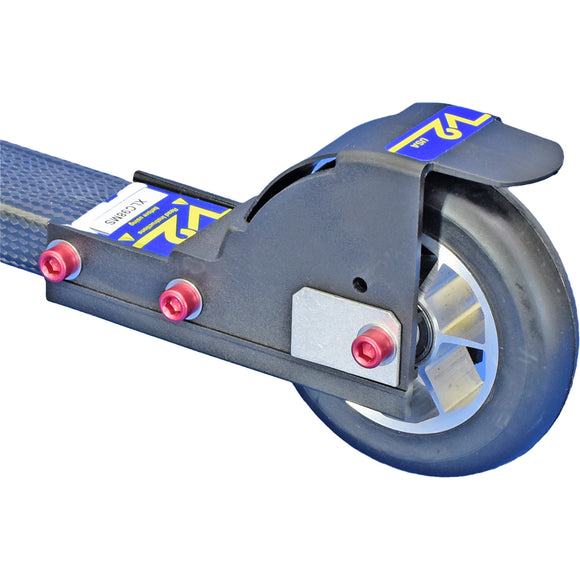The XLC are the lightest and the most snow like solid rubber wheel roller skis V2 have ever produced. The vibration damping of the new composite frame is exceptional, and, coupled with the shock absorbing wheel forks, the XLC makes skiing on pavement as similar to skiing on snow as possible. In addition to lower ski weight and the improved vibration damping, another advantage of the XLC is a lower center of gravity. The clearance from the pavement to the bottom of the shaft is the same, but with the strong construction we can make the shaft thinner, so the top of the shaft is lower, making the skis more stable. Safety is high priority at Jenex, so all XLC models are available with our patented brakes and speed reducers. For skiers weighing over 90 Kg (199 pounds), there is the XLC in a Heavy Duty (HD) version that is about 25% stiffer.
COMPOSITE FIBERS: Over the last twenty years V2 has tested most high strength synthetic fibers, including the many variants of Carbon, S glass, E glass and Aramid. All of these fibers have strengths and weaknesses. Aramid (KevlarTM) fibers have high tensile strength, dampen vibration and are extremely abrasion resistant, but are very weak in compression. Carbon is extremely stiff and strong in both tension and compression, but breaks very easily from impact, which is why so many Carbon ski poles break in sprint and mass start races. Carbon is a great material, but to prevent impact failure Carbon fiber shafts need a core with good energy absorbing properties and perform best when combined with more impact resistant fibers. And that’s what we have with the XLC.
THE CORE: The core material is the foundation of a roller ski shaft and V2 has tried about every material available including a variety of metal cores. We have used organic cores like Baltic birch, Italian poplar, Balsa and many synthetic cellular cores. V2 believes from extensive experience that for roller skis, cellular cores are superior to metal cores. The XLC uses the best core V2 has tested to date. However, fabricating the cellular core is time consuming and expensive compared to an extruded core.
BONDING: Composite structures need a very strong bond to both the fibers and the core. Bonding high strength fibers to a metal core can be more difficult than bonding to a porous cellular core. The metal must be aggressively etched for the fibers to bond properly. The cellular core we use has thousands of microscopic pores per square centimeter, and therefore the epoxy penetrates and bonds extremely well the core. The epoxy that binds the fibers to themselves and to the core has a tensile strength about 3X greater than conventional epoxies and is the strongest commercially available.
The wheel forks have much better fenders than the original 800 and 900 series skis. The combination fork and fenders are produced in Du Pont’s™ toughest thermoplastic, further strengthened with the addition of carbon fibers during the injection molding process. The non-metallic wheel forks reduce vibration, and for improved safety, all V2 Roller Skis are designed to accept the patented Jenex speed reducers and brakes.
The four XLC98 models are identical except for wheel speed. The XLC98F is fast, The XLCM is medium, the XLC98MS is medium slow and the XLC98S is slow. The rolling resistance of the slow wheels is increased using our patented ISR (internal speed reducer) that weighs only 10 grams. The wheel forks, with the built-in fenders, use the same strong Du Pont™ composite material that V2 has employed on the V2-900 and V2-800 series for many years.
Product title
Vendor
$19.99 | $24.99
Product title
Vendor
$19.99 | $24.99
Product title
Vendor
$19.99 | $24.99
Product title
Vendor

